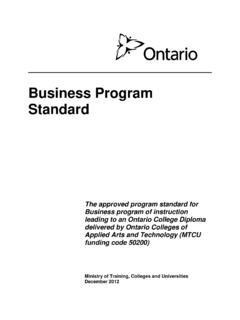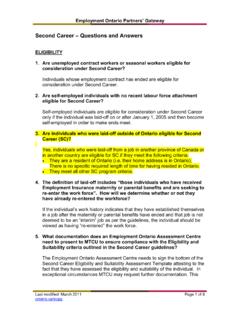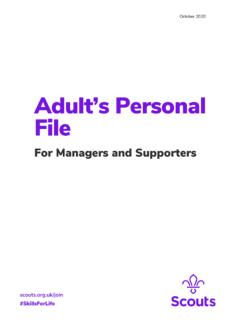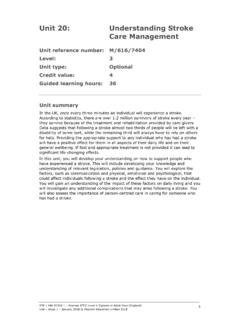Transcription of How To Use the “Checklist for Evaluating Learning Materials”
1 This document contains both information and form fields. To read information, use the Down Arrow from a form Adult Literacy Curriculum FrameworkHow To Use the Checklist for Evaluating Learning Materials Ontario Ministry of Training, Colleges and Universities March 2011 OALCF | How to Use the Checklist for Evaluating Learning Materials | i Contents What is this document about? ..1 Introducing the Checklist for Evaluating Learning Materials ..1 How was the Checklist for Evaluating Learning Materials developed? ..1 How is the Checklist organized? ..2 Examining the Checklist in detail.
2 3 Describing the Quality of Content section ..3 Describing the Potential Effectiveness as a Teaching- Learning Tool section ..3 Describing the Ease of Use (for Practitioners and learners ) section ..4 Describing the Comments section ..4 The Checklist in Action: Kitchen Math Example ..5 Filling out the Content section of the checklist ..5 Answering the evaluative questions and providing comments ..5 Checklist for Evaluating Learning Materials .. 19 OALCF | How to Use the Checklist for Evaluating Learning Materials | 1 What is this document about? How to Use the Checklist for Evaluating Learning Materials introduces you to the Checklist for Evaluating Learning Materials by o providing information on its purpose and development o detailing the six Ontario Adult Literacy Curriculum Framework (OALCF)
3 Principles on which it is based o describing the checklist s five sections illustrates how to use the checklist by Evaluating an actual Learning material provides a blank checklist for Evaluating your own Learning materials Introducing the Checklist for Evaluating Learning Materials With the implementation of the new Ontario Adult Literacy Curriculum (OALCF), practitioners in the Literacy and Basic Skills (LBS) Program will need to evaluate the extent to which their program practices support adult learners in a task-based and goal-dir ected Learning environment. Specifically, as a volunteer tutor, instructor, or program coordinator, you will need to evaluate your Learning materials to determine their effectiveness within the OALCF.
4 To help you in your work, the Checklist for Evaluating Learning Materials has been developed. The checklist provides a set of standard questions to evaluate Learning materials ensuring greater quality and consistency of programming and a competency- and goal-directed program approach. You can use the checklist to evaluate both print and non-print Learning materials, such as books, workbooks, video collections, software, and websites. How was the Checklist for Evaluating Learning Materials developed? The following six principles guided the development of the OALCF: 1. Address learner needs first and foremost.
5 The Checklist for Evaluating Learning Materials identifies materials according to the learner s culture, language, and goal path. Using the checklist will enable you to assess the match between the Learning material and learner s needs, interests, goal, and culture helping to ensure that your programming is learner-centered, relevant, and meaningful. 2. Make practitioners jobs easier. The Checklist for Evaluating Learning Materials will display the results of your evaluation in an easy-to-read format. Then, both you and the learners in your program can easily find Learning materials that best match their needs.
6 3. Be appropriate for, and accessible to, learners and practitioners with diverse cultural needs. The Checklist for Evaluating Learning Materials asks you to identify the cultural group of the target audience for the Learning material. In this way, you can easily find resources reflecting the cultural values and language of learners . OALCF | How to Use the Checklist for Evaluating Learning Materials | 2 4. Be accountable to the public. The Checklist for Evaluating Learning Materials helps you evaluate a Learning material that may already be in your delivery agency s collection or may be a resource that your agency intends to buy.
7 5. Be built on a specified, strong theoretical foundation consistent with andragogy. The Checklist for Evaluating Learning Materials uses evaluative questions that directly reflect adult Learning principles. Specifically, the questions take into account that learners are self-directed want to be engaged in decisions affecting them have life experiences and knowledge are goal-oriented must see the reason for Learning something are practical need to be treated with respect 6. Be clear to learners , practitioners, the Ministry of Training, Colleges and Universities (MTCU), and other stakeholders.
8 The Checklist for Evaluating Learning Materials makes explicit the connection between a particular Learning material and the OALCF s competency- and task-based program approach. The development of the checklist was informed by various educational and institutional sources. Specifically, the evaluative questions and the categories into which they are grouped were adapted from MERLOT-Multimedia Education Resource for Learning and Online Teaching. You can access this resource at To further understand the key concepts and rationale that informed the development of the Checklist for Evaluating Learning Materials, please read Foundations of Learning Materials ( ), available from the Linking Learning Materials to the OALCF web page of the OALCF website.
9 How is the Checklist o rganized? The Checklist for Evaluating Learning Materials is comprised of the following five sections: 1. Content 2. Quality of Content 3. Potential Effectiveness as a Teaching- Learning Tool 4. Ease of Use (for Practitioners and learners ) 5. Comments The blank checklist at the back of this document shows the five sections. OALCF | How to Use the Checklist for Evaluating Learning Materials | 3 LowHighExamining the Checklist in detail The first part of the checklist is the Content section. Here you identify the name of the Learning material and its cultural orientation, the goal path to which it relates, and the predominant and secondary competencies it supports.
10 You also indicate the date of your evaluation. The Content section is followed by three sections, Quality of Content, Potential Effectiveness as a Learning -Teaching Tool, and Ease of Use (for Practitioners and learners ). These three categories organize the 13 evaluative questions that further determine the fit of a Learning material within the OALCF. Taken as a whole, the questions help to ensure that the Learning material matches the OALCF s learner-centred, goal-directed, competency-based, and task-based approach to programming. To answer each evaluative question, you will use the scale shown in Figure 1 to rate the Learning material from low to high.












